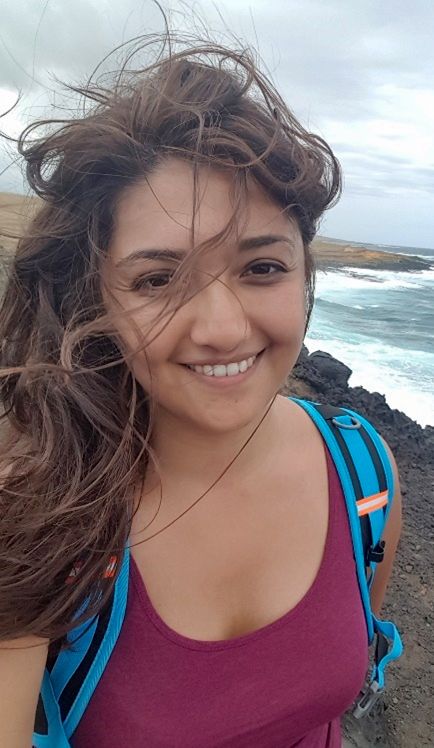Early Career Scientist Spotlight
Dr. Danna Qasim
Experimental Astrochemist
Astrochemistry Laboratory
What is one of your favorite moments in your career so far?
One of my favorite and most proud moments in my career so far is when I actually stuck to and succeeded in my earlier career despite having encountered severe barriers. Some years ago, I enrolled in the PhD program at Emory University to specialize in astrochemistry. After a mere 1 year of enrollment, I was deemed unqualified to continue the graduate program and was immediately dismissed. To keep a long and painful story short, I essentially did not agree with the way I was evaluated, and believed in myself that I could do better. Many people were skeptical, and it was a challenging uphill climb to get back into academia. Yet, the situation also brought a blessing – it naturally paired me with advisors and faculty that were open-minded and highly supportive of my scientific dreams. I eventually completed my MSc in chemical sciences with 2 publications, and my PhD in astronomy with 11 publications, including a first-author paper in Nature Astronomy. Honestly, I would not trade any experience that I encountered during that whole process for the world.

Credit: Qasim family
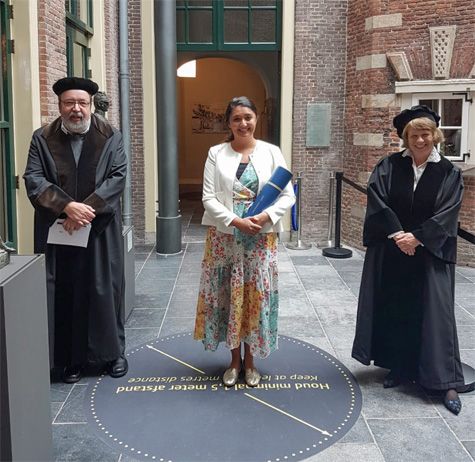
Credit: Chiel Schoenmaker
What research accomplishment are you most proud of?
The research accomplishment that I am most proud of, no doubt, is my first first-author paper from my master’s, because it was THE underdog paper. As I had mentioned in the previous section, I experienced heavy skepticism on my abilities as a scientist before entering my master’s. My master’s advisor, Prof. Dr. Heather Abbott-Lyon, greatly supported me, but her lab was within a Primarily Undergraduate Institution (PUI), which meant limited funding for research. Creativity, persistence, and MacGyvering with some amazingly dedicated undergraduate students lead us to publishing the first paper for the lab, for Heather as an advisor, and for myself as a student. That paper will always be my favorite paper.
What is your research focus?
Broadly speaking, my research focuses on understanding the composition and distribution of simple and complex molecules across various stages in the stellar formation cycle. Particularly, my interests are in extraterrestrial minerals and interstellar ices, as a lot of fascinating chemistry happens in the solid-state! In my master’s, using cryogenic surface science techniques, I focused on characterization of the reactivity of the surface of a meteoritic mineral, schreibersite (Fe2NiP), which is a mineral that may have contributed to abiotic phosphorylation reactions on the early Earth. Although schreibersite has been demonstrated to phosphorylate biomolecules in aqueous solution, the role of its surface in the phosphorylation process was always in question. We showed that the mineral surface is chemically active, and that its structure may act as a catalyst, both of which showcase that the mineral is more than just a source of phosphorus.
In my doctorate, also using cryogenic surface science techniques, I investigated the formation of interstellar icy complex organic molecules (COMs). These molecules were typically thought to be initially formed by radiation from the local star and cosmic rays. In recent years, we have demonstrated that COMs can be formed without such radiation at the low temperature of 10 K, simply through the accretion of reactive atoms and molecules. Thus, COMs should already be formed way before the star is born – a finding that changes the general view of the origins of COMs.
And now for my postdoc, I am studying the combination of meteorites and interstellar ices. Specifically, I am trying to understand to what extent interstellar ices affect the composition of meteorites after they are aqueously altered in meteorite parent bodies. This project requires multiple techniques, laboratories, and expertise, which makes it a bit intimidating. But as with many challenging endeavors, the experience gained and outcomes can be highly rewarding.
Tell us about one project that has been particularly impactful in your field.
One project of mine that is growing to be impactful in my field is the overall development of an atomic carbon source that can be used to study carbon atom addition chemistry in interstellar ice analogues, in which the first scientific results were published in Nature Astronomy. It is known that the first ices of our universe are formed by the accretion of atoms and small molecules onto dust grains. This is how the simple hydrides, such as H2O (H-addition to O), NH3 (H-addition to N), and CH4 (H-addition to C), are formed. Although this concept has been generally accepted by the community for decades, there is almost no information on C-atom chemistry, largely because C-atom addition in interstellar ice analogues was never experimentally tested under controlled laboratory conditions. Now that an atomic carbon source has been developed for such applications, not only can we truly verify and characterize the formation of simple molecules such as CH4, but we are also able to explore a whole new dimension of how the carbon backbone is formed in interstellar COMs, which are the first organics of our universe.
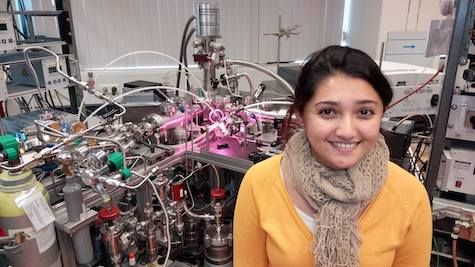
Credit: Dr. Xavier Bacalla
What are your future research interests and goals?
I am fascinated with the role of minerals in prebiotic chemistry. I think that, in many aspects of astrochemistry and astrobiology, the role of mineral-induced chemistry is underexplored, in part because mineral dynamics are challenging to study. In aqueous chemistry reactions that involve minerals, disentangling the overall formation mechanism cannot be done unless the role of the mineral surface is indeed found to be negligible. In the interstellar ice world, the involvement of the dust grain in interstellar ice chemistry is ignored too much, in my opinion, as there is a diverse set of minerals which make up the dust grains that ices are formed on. Some of these astrochemically/astrobiologically relevant minerals are actually used in industry as heterogeneous catalysts, so one would expect them to also have active roles in prebiotic chemistry. I do believe that it is difficult to find appreciation in something when there is a lack of relevant expertise, and that may be the case for the study of mineral-induced prebiotic chemistry. It is my hope that I will be able to work with others in the field on understanding the extent to which minerals play a part in forming the building blocks of life.
What is one space mission that you are particularly excited about, and why?
The James Webb Space Telescope (JWST)! In the field of interstellar ices and COMs, the JWST is expected to provide a waterfall of data that cannot be obtained with current observational facilities. A big topic that has been lingering in our field is an all-encompassing understanding of the formation of interstellar methanol ice. Methanol is one of the most abundant ices to be detected and considered to be a key precursor to the formation of more complex organics. Yet, there are less than 10 detections of methanol ice towards background stars, and comparison of the detections with each other and with upper limits of methanol ice tell us that we simply do not have enough data points to fully understand the conditions that lead to methanol ice formation. The JWST has the capability to do ice mapping with high sensitivity, which would (in theory) allow observations of methanol ice towards more than 100 background stars! This is just one problem that the JWST will be able to tackle, and I cannot wait to see all the other puzzling topics that the JWST will shed light on.
What do you like to do in your free time?
As I have moved every 4 years since I was 18 (!), what I like to do in my free time has also changed every 4 years. Moving from Tucson to Flagstaff, Arizona, I thoroughly enjoyed exploring downtown Flagstaff with my new college friends, and making road trips to local canyons and creeks.
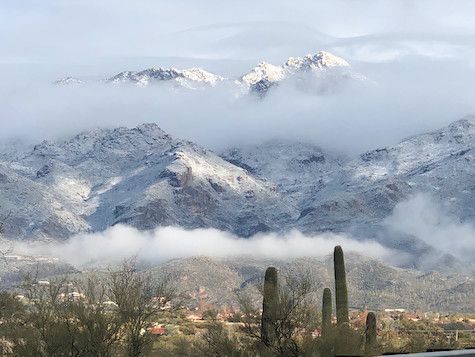
Credit: Nedal Qasim and neighbors
Moving to Atlanta, Georgia, there were a lot of lakes, so I took up stand up paddle boarding. Heading up north to the Netherlands, I found myself bragging about my latest Belgian beer find with other enthusiasts. And now finally coming to Maryland, I am living in a really cozy and nice apartment, and am enjoying cooking all the American food that I (surprisingly) missed while overseas.
Some things have also remained constant over the years, such as my love for running, decorating, and the art of self-care.

Credit: Dr. Alex Wolfarth
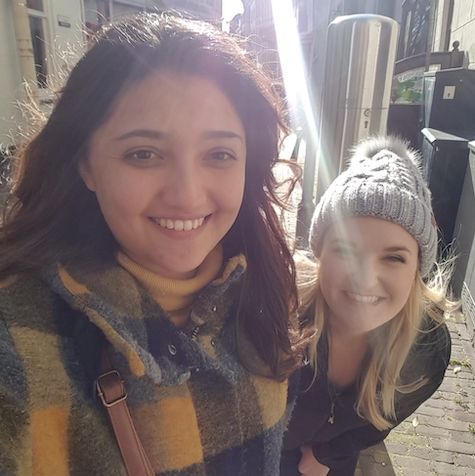
Credit: Danna Qasim
Biography
Home Town:
Tucson, Arizona, USA
Undergraduate Degree:
BS Chemistry, Northern Arizona University, Flagstaff, Arizona, USA
Post-graduate Degrees:
M.Sc., Chemical Sciences, Kennesaw State University, Kennesaw, Georgia, USA
Ph.D., Astronomy, Leiden University, Leiden, the Netherlands
